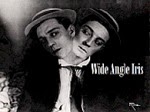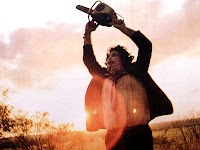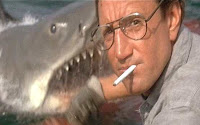The Twilight Saga: New Moon
Directed by Chris Weitz
One and One Half Stars
“The Twilight Saga: New Moon” is composed entirely of attractive people making voluptuous expressions, sometimes at one another, usually at the corners of the screen. The film is nothing more than a visual companion, a template of pretty faces that prepubescent teens can gawk at while they recall Stephanie Meyer’s popular novel in their minds. It is a single note held for two hours, littered with thoroughly irrational characters occupying a dimwitted story. But then again, the faces are pretty, the expressions voluptuous.
I guess that’s all that director Chris Weitz really intended. Most of the people who see this movie will already know its secrets, which makes it more of an exhibition for the bare chests of its toned male leads. Kristin Stewart, on the other hand, hardly ever even wears short sleeves. This is a tale of chastity after all.
“New Moon” picks up more or less where last year’s “Twilight” left off. Bella (Stewart) has just turned 18 and displays her innate knack for turning even the most modest of joys into cause for sorrow. With another year under her belt, she is reminded of the simple fact that she is aging, a curse that her pale skinned hubby Edward Cullen (Robert Pattinson) could fix with a little nip on the neck.
But alas, after an unfortunate incident at the Cullen family mansion, Edward decides, in the film’s only application of legitimate rationality, that Bella’s obsession with becoming a member of the elite undead is call for concern. The Cullens pack up and leave town and Bella is left, well, about as despondent as she seemed before.
Bella finds some arbitrary solace in the suspiciously buff Jacob Black (Taylor Lautner), but is haunted by images of her beloved Eddy, usually advising her not to choose the stupidest option available at present (Don’t get on the bike with the potential rapist, Bella). Bella works out all by herself that making stupid decisions will summon this image of Eddy telling her not to make stupid decisions, so she goes into adrenaline-junky mode, fixing up a pair of bikes with Jacob, introducing hers to a rock, and then literally jumping off a cliff.
All of this is a prelude to the film’s primary revelation. I don’t feel as though I’m spoiling it for anybody when I say that Jacob is a werewolf, running with a gang of other werewolves who do a lot of running about topless in the rain until the story demands that they assume more animal like characteristics.
From here there’s some globetrotting, mind reading, and a lot more brooding. Bella and Eddy’s love for one another is exemplified in moments of tender dialog in which they talk about how much they love one another. There’s no real investigation of the couple’s feelings. They love each other, now shut up. Finally, after two hours and in true franchise form, “New Moon” ham-handedly sets up for the sequel. Tune in next year to see if Bella and Edward will continue to be miserably in love together.
Why this story is popular with women I will never know. Surely in an age of liberated, working, and independent women, they’re not sympathizing with Bella? Here is an eighteen year old girl who is more than willing to sacrifice her education, her devoted and loving father, and even her soul so that she can be with her high school sweetheart. Is this what you ladies find romantic? Bella needs a therapist, not a husband.
If “New Moon” sends a damaging message about women’s place in society (and it does), it’s because it is written by a woman who doesn’t seem to understand what that place is. Weitz does what he can with the material, but he’s too subservient to Meyer’s naivety to bring any substance to it. The project is undone by its obsessive loyalty, which is strangely appropriate.
I guess that’s all that director Chris Weitz really intended. Most of the people who see this movie will already know its secrets, which makes it more of an exhibition for the bare chests of its toned male leads. Kristin Stewart, on the other hand, hardly ever even wears short sleeves. This is a tale of chastity after all.
“New Moon” picks up more or less where last year’s “Twilight” left off. Bella (Stewart) has just turned 18 and displays her innate knack for turning even the most modest of joys into cause for sorrow. With another year under her belt, she is reminded of the simple fact that she is aging, a curse that her pale skinned hubby Edward Cullen (Robert Pattinson) could fix with a little nip on the neck.
But alas, after an unfortunate incident at the Cullen family mansion, Edward decides, in the film’s only application of legitimate rationality, that Bella’s obsession with becoming a member of the elite undead is call for concern. The Cullens pack up and leave town and Bella is left, well, about as despondent as she seemed before.
Bella finds some arbitrary solace in the suspiciously buff Jacob Black (Taylor Lautner), but is haunted by images of her beloved Eddy, usually advising her not to choose the stupidest option available at present (Don’t get on the bike with the potential rapist, Bella). Bella works out all by herself that making stupid decisions will summon this image of Eddy telling her not to make stupid decisions, so she goes into adrenaline-junky mode, fixing up a pair of bikes with Jacob, introducing hers to a rock, and then literally jumping off a cliff.
All of this is a prelude to the film’s primary revelation. I don’t feel as though I’m spoiling it for anybody when I say that Jacob is a werewolf, running with a gang of other werewolves who do a lot of running about topless in the rain until the story demands that they assume more animal like characteristics.
From here there’s some globetrotting, mind reading, and a lot more brooding. Bella and Eddy’s love for one another is exemplified in moments of tender dialog in which they talk about how much they love one another. There’s no real investigation of the couple’s feelings. They love each other, now shut up. Finally, after two hours and in true franchise form, “New Moon” ham-handedly sets up for the sequel. Tune in next year to see if Bella and Edward will continue to be miserably in love together.
Why this story is popular with women I will never know. Surely in an age of liberated, working, and independent women, they’re not sympathizing with Bella? Here is an eighteen year old girl who is more than willing to sacrifice her education, her devoted and loving father, and even her soul so that she can be with her high school sweetheart. Is this what you ladies find romantic? Bella needs a therapist, not a husband.
If “New Moon” sends a damaging message about women’s place in society (and it does), it’s because it is written by a woman who doesn’t seem to understand what that place is. Weitz does what he can with the material, but he’s too subservient to Meyer’s naivety to bring any substance to it. The project is undone by its obsessive loyalty, which is strangely appropriate.
Rollan Schott
November 23, 2009
Originally Featured in the Daily Nebraskan



















